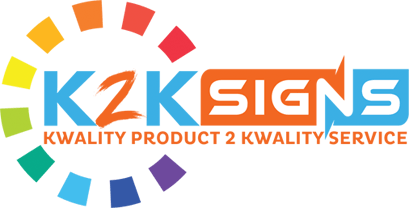Road Signs in Australia
Road signs in Australia regulate traffic, warn of hazards, and guide road users. They follow national standards to ensure safety and uniformity across highways, urban areas, and rural roads.
This guide covers Australian road signs' types, materials, regulations, and installation.

Australian road signs are divided into regulatory, warning, and guide signs. They follow strict standards (AS 1742, AS/NZS 1906.1) and use specific colours for visibility. For durability, signs are made of aluminium and reflective sheeting. They are essential for highways, urban streets, and construction zones. Buy compliant road signs from K2K Signs.
What Are the Different Types of Road Signs in Australia?
Australia uses regulatory, warning, and guide signs to control traffic and provide road users with necessary information.
- Regulatory Signs: Enforce traffic laws. Examples: Stop signs, speed limit signs, no entry signs.
- Warning Signs: Alert drivers to potential hazards. Examples: Sharp curve ahead sign, pedestrian crossing, wildlife warning signs.
- Guide Signs: Provide location and directional information, such as exit signs, highway route markers, and town direction signs.
What Are the Standard Colours and Shapes of Road Signs in Australia?
- Red and White: Regulatory signs (e.g., stop, give way, speed limits).
- Yellow and Black: Warning signs (e.g., roadworks, wildlife crossings).
- Green and White: Guide signs (e.g., freeway exits, street names).
- Blue and White: Service signs (e.g., rest areas, hospitals, parking zones).
- Brown and White: Tourist signs (e.g., national parks, heritage sites).
What Materials Are Used for Road Signs in Australia?
Road signs are made from high-quality, weather-resistant materials:
- Aluminium: Lightweight, rust-proof, and durable.
- Reflective Sheeting: Increases nighttime visibility using Class 1 and Class 2 reflective materials.
-
Steel: Used for strong, heavy-duty applications like motorway signage.
What Are the Australian Road Sign Standards?
Australian road signs comply with:
- AS 1742: Manual of Uniform Traffic Control Devices.
- AS/NZS 1906.1: Retroreflective materials for traffic control.
-
AS 4049.4: Paints and coatings for road marking.
Where Are Road Signs Used in Australia?
Road signs are installed on:
- Highways and Motorways: Speed limits, exits, lane directions.
- Urban Streets: Parking restrictions, pedestrian crossings, stop and give-way signs.
- Construction Zones: Roadwork warnings, temporary detours.
-
Rural Areas: Wildlife crossings, unsealed road warnings.
How Are Road Signs Installed and Maintained?
- Installation: Mounted on steel or aluminium posts using brackets or direct fixing.
-
Maintenance: Regular inspections for visibility, damage, and compliance with road safety regulations.
Where to Buy Road Signs in Australia?
K2K Signs provides Australian-standard road signs for councils, construction companies, and businesses nationwide. Browse regulatory, warning, and custom signage options at K2K Signs.

